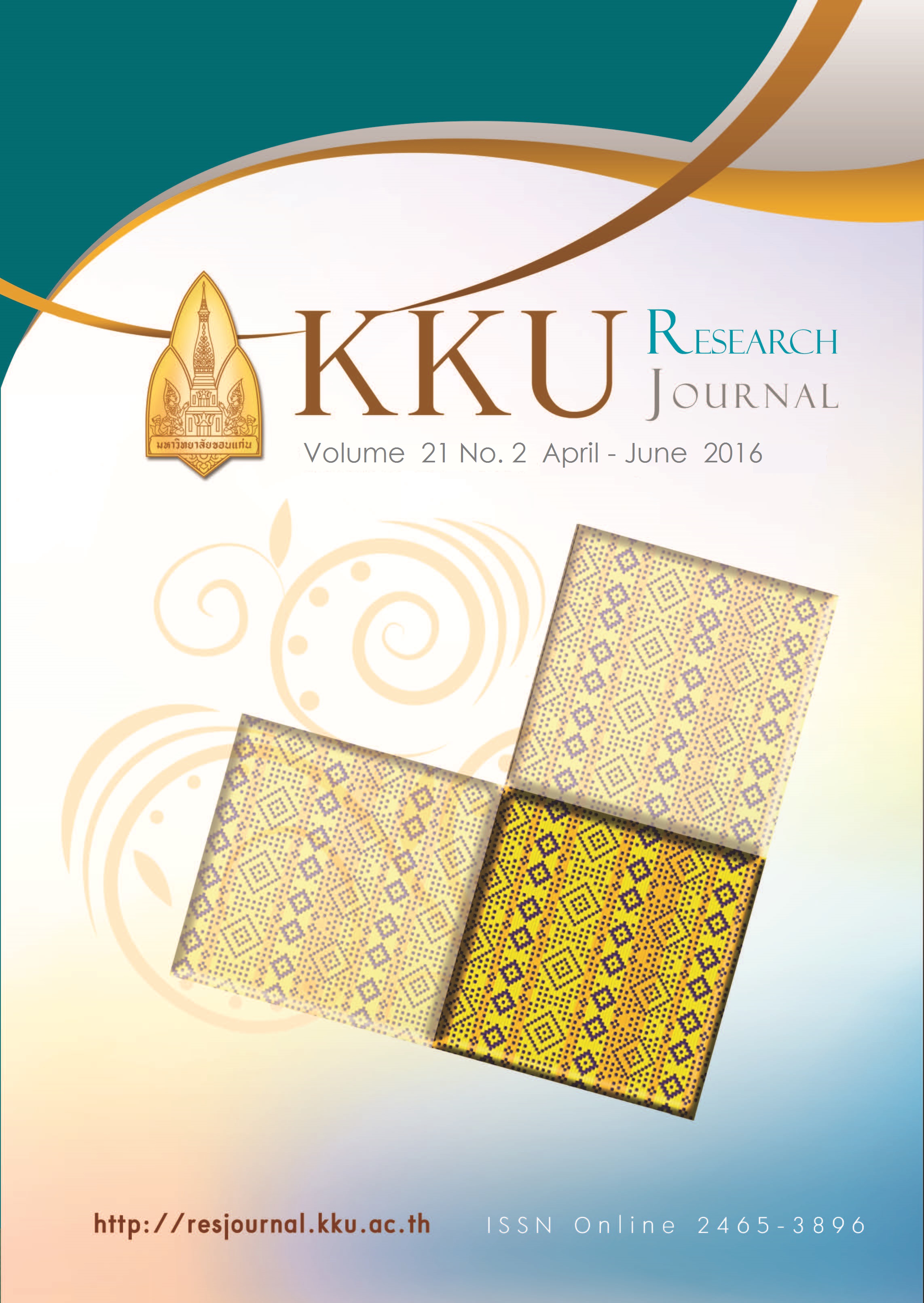Influence of solvent extract on properties of biomaterial PHA derived from Novosphingobium sp. THA_AIK7
Main Article Content
Abstract
Polyhydroxyalkanoates (PHA) production by Novosphingobium sp. THA_AIK7 was investigated in Mineral salt medium (MSM) supplemented with 2% (v/v) of crude glycerol as a carbon source. The polymer were extracted by sodium hypochlorite and chloroform. Both of extracted films was white, opaque and has a smooth surface. PHA film
casting from sodium hypochlorite extraction had bigger pore size than chloroform casted film. The contact angle obtained from polystyrene tissue culture plate (TCP), sodium hypochlorite and chloroform casted film were 78, 81 and 80 degree, respectively. Decomposition temperature (Td), melting temperature (Tm) and crystallization temperature (Tc) were examined against PHB standard. Td of 285, 299 and 298°C were acquired from PHB, sodium hypochlorite and chloroform casted film, respectively. Tm value of 170, 167 and 178°C and Tc value of 66, 54 and 92°C were acquired from sodium hypochlorite, chloroform and PHB, respectively. Biocompatibility study of PHA film was tested with Vero cell. Vero cells grown on tissue culture plate (TCP) presented typical fibroblast morphology. However, Vero cells were unable to adhere on sodium hypochlorite casted film and consequently cell lysis was observed. Vero cells could attach on chloroform casted film but could not develop normal fibroblast appearance and was incapable of proliferating on casted film. The results shown here indicated that the extraction methods were still not proper for biocompatible test. The finding of a suitable method for biomaterial preparation will be done in the next phase.
Article Details
References
[2] A n d e r s o n A J , D a w e s E A . Occurrence, metabolism, metabolic role and industrial uses of bacterial PHA. Microbiol Molecular Biol Rev. 1990;54:450-72.
[3] Berger E, Ramsay BA, Ramsay JA, Chavarie C, Braunegg G. PHB recovery by hypochlorite digestion of non-PHB biomass. Biotechnol Tech. 1989;3:227-32.
[4] Cavalheiro JMBT, de Almeida M. Catarina MD, Grandfils C, da Fonseca MMR. Poly(3-hydroxybutyrate) production by Cupriavidus necator using waste glycerol. Process Biochemistry. 2009;44: 509-15.
[5] Guo W, Duan J, Geng W, Feng J, Wang S, Song C. Comparison of medium-chain-length polyhydroxyalkanotes
synthase from Pseudomonas mendocina NK-01 with the same substrate specificity. Microbiological Research. 2013;168:231-37.
[6] Kawahara K, Tanaka A, Yoon J, Yokota A. Reclassification of a p a r a t h i o n e - d e g r a d i n g Flavobacterium sp. ATCC 27551 as Sphingobium fuliginis. J Gen Appl Microbiol. 2010;56:249-55.
[7] Lu X, Wen X, Yang D. Isothermal crystallization kinetics and morphology of biodegradable poly(3-hydroxybutyrate-co-4-hydroxybutyrate). J Mater Sci. 2011;46:1281-88.
[8] Ramsay BA, Lomaliza K, Chavarie C, Dube B, Batalille P, Ramsay JA. Production of Poly-(β-hydroxybutyric-co-β-hydroxyvaleric) Acids. A p p l E n v i r o n M i c r o b i o l . 1990;56:2093-98.
[9] Steinbüchel A. Perspectives for biotechnological production and utilization of biopolymers: m e t a b o l i c e n g i n e e r i n g o f polyhydroxyalkanoate biosynthesis pathways as a successful example. Macromol Biosci. 2001;1:1-24.
[10] Steinbüchel A, Valentin HE. D i v e r s i t y o f b a c t e r i a l polyhydroxyalkanoic acids. FEMS Microbiol Lett. 1995;128:219-28.
[11] Takeuchi M, Hamana K, Hiraishi A . P r o p o s a l o f t h e g e n u s Sphingomonas sensu stricto and three new genera, Sphingobium, Novosphingobium and Sphingopyxis, on the basis of phylogenetic and chemotaxonomic analyses. Int J Syst Evol Microbiol. 2001;51:1405-17.
[12] Teeka J, Imai T, Reungsang A, Cheng X, Yuliani E, Yamaguchi J, Poomipuk N, Tiantanunkul J, Jeenanong A, Higuchi T, Yamamoto K, Sekine M. Characterization of Polyhydroxyalkanoates (PHA)
b i o s y n t h e s i s b y i s o l a t e d Novosphingobium sp. THA_AIK7 using crude glycerol. J Ind Microbiol Biot. 2012;39:749-58.
[13] Verlinden RAJ, Hill DJ, Kenward MA, Williams CD, Radecka I. Bacterial synthesis of biodegradable Polyhydroxyalkanoates. J Appl Microbiol. 2007;102:1437-49.
[14] Williams SF, Martin DP, Horowitz DM, Peoples OP. PHA application: addressing the price performance issue I. Tissue engineering. Int J Biol Macromol. 1999;25:111-21.
[15] Yuan, Y. and Lee, R. Contact angle and wetting properties. Surface science techniques. 2013. Volume 51 of the series Springer Series in Surface Sciences pp 3-34. DOI : 10.1007/978-3-642-34243-1_1
[16] Zhang DM, Cui FZ, Luo ZS, Lin YB, Zhao K, Chen GQ. Wettability i m p r o v e m e n t o f b a c t e r i a l
polyhydroxyalkanoates via ion implantation. Surface and Coating Technology. 2000;131:350-54.
[17] Zhao K, Deng Y, Chen JC, Chen GQ. Polyhydroxyalkanoate (PHA) scaffolds with good mechanical properties and biocompatibility. Biomaterials. 2003;24:1041-45.
[18] Zheng Z, Bei FF, Tian HL, Chen GQ. Effect of crystallization of polyhydroxyalkanoate blend on surface physicochemical properties and interactions with rabbit articular cartilage chondrocytes. Biomaterials. 2005;26:3537-48.


